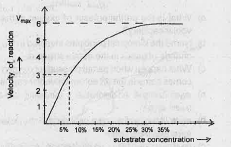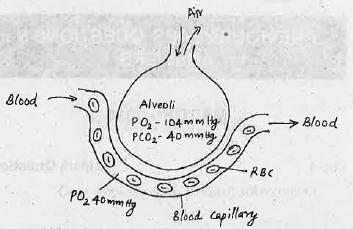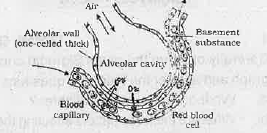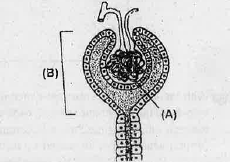Complete Solutions to Exercise of chapter BREATHING AND EXCHANGE OF GASES of Class 11 book with complete answers and questions
| Class 11 | BIOLOGY |
| Chapter | BREATHING AND EXCHANGE OF GASES |
| MAXIMUM PUBLICATION | Exercise |
| Number Of Questions | 98 |
| Academic Year | 2023-24 |
Respiration in insects is called direct because
View SolutionMark the true statement among the following with reference to normal breathing
View SolutionInspiration and expiration are passive processes A person breathes in some volume of air by forced inspiration after having a forced expiration. This quantity of air taken in is
View SolutionIncidence of Emphysema - a respiratory disorder is high in cigarette smokers. In such cases
View SolutionRespiratory process is regulated by certain specialized centres in the brain. One of the following listed centres can reduce the inspiratory duration upon stimulation
View Solution`CO_2+H_2Orightarrow H_2CO_3 rightarrow HCO_3^- +H+` These all the reactions that takes place in accordance with respiration. Br Where these reactions takes place?
View Solution`CO_2+H_2Orightarrow H_2CO_3 rightarrow HCO_3^- +H+` These all the reactions that takes place in accordance with respiration. Br Which is the enzyme present here?
View SolutionFill in the table with appropriate heading values.

View SolutionIn the following diagram A represent Total lung capacity and B represent Vital capacity and then C represent what?

View SolutionName the biological principle involved in the exchange of gas between lungs and blood.
View SolutionWhat is the percentage of oxygen transported by Haemoglobin in the form of Oxyhaemoglobin?
View SolutionOxyhaemoglobin `rightarrow` Oxygen + Hb. Where does this process takes place ?
View SolutionOxyhaemoglobin `rightarrow` Oxygen + Hb. What are the factors that influence 02 dissociation curve ?
View SolutionBar diagram showing oxygen transport is shown below.
 Name the two methods of oxygen transport.
Name the two methods of oxygen transport.
View SolutionMatch the following.
View SolutionEmphysema' is a term linked with 'Respiratory system'. What is emphysema?
View SolutionDraw a flow chart showing the air passage in the human respiratory system. Br (Trachea, nasal cavity, nasopharynx, bronchi, nos-trils, alveoli, bronchioles, larynx)
View SolutionStudy the graph and answer the following questions.
 What is represented by the graph ?
What is represented by the graph ?
View SolutionStudy the graph and answer the following questions.
 Find out the pressure at which Haemoglobin is 50% saturated with `O_2`?
Find out the pressure at which Haemoglobin is 50% saturated with `O_2`?
View SolutionName the structural and functional unit of lungs.
View SolutionWhy the lungs replaces the skin in Mammals as respiratory organ.
View SolutionThe `pO_2` in cell cytoplasm is always lower than the capillary blood while `pCO_2` is greater. How do you account for this?
View SolutionA dog expires `CO_2`, How can you correlate the relationship between the dog and grazing cattle in terms of `CO_2`.
View SolutionAnalyse the concept map given below and if have mistakes reconstruct it.

View SolutionA person exhaled nearly more than 3000 ml of air during a breathing exercise. How do you justify that act?
View SolutionIn order to give the awareness about healthy practices to reduce respiratory disorders, prepare a pamphlet.
View SolutionThe venous blood in the lungs has a `pCO_2` of 46mm Hg. Should the alveolar `pCO_2` exceeds or be less than 46mmHg to result in diffusion of `CO_2` from the blood into alveolus?
View SolutionHuman respiration is controlled by intercostal muscles in the ribs and diaphragm. Justify this statement.
View SolutionWhile analysing the blood of normal healthy person, it has been found that the amount of `HCO_3` ions in his venous blood is much higher than his arterial blood. How do you account for this increase of `HCO_3` ions.
View SolutionPlace the following in the correct order. Lungs expand, rib rise, air enters lungs, external intercostal muscle contract, thorax expands.
View SolutionPneumatoxic centre has an important role in E regulating rate of respiration. Prepare a flow chart representing the regulation of respiration by pneumatoxic centre during strenuous exercise.
View SolutionTransport of CO2, as Bicarbonates.
 Copy the diagram and fill the gaps.
Copy the diagram and fill the gaps.
View SolutionTransport of `CO_2`, as Bicarbonates.
 Name the other ways of `CO_2` transport.
Name the other ways of `CO_2` transport.
View SolutionTransport of `CO_2`, as Bicarbonates. If blood chlorine level decrease, does it affect gas transport? Justify.
View SolutionAnalyse the flow chart.
 Distinguish the function of external and internal intercostal muscles.
Distinguish the function of external and internal intercostal muscles.
View SolutionAnalyse the flow chart.
 Distinguish the function of external and internal intercostal muscles.
Distinguish the function of external and internal intercostal muscles.
View SolutionPharynx is a common passage for air and food. Name the part for the passage of food.
View SolutionPharynx is a common passage for air and food. Name the part for the passage of air.
View SolutionPharynx is a common passage for air and food. How do these passage work without any problems?
View SolutionFollowing figure shows a microscopic section through the alveoli in the lungs of man.
 Give the features visible in the diagram that help to increase the rate of diffusion across the wall of the alveoli into the blood.
Give the features visible in the diagram that help to increase the rate of diffusion across the wall of the alveoli into the blood.
View SolutionA person inhales to his maximum capacity and then he exhales also to his maximum. a) What term would you use for the volume of air thus breathed out.
View SolutionA person inhales to his maximum capacity and then he exhales also to his maximum. What is the volume of air thus breathed out?
View SolutionA person inhales to his maximum capacity and then he exhales also to his maximum. Suppose he hold his breath after that maximum expiration for 5 seconds would there be any exchange of respiratory gases occuring in lungs during that period. How?
View SolutionHuman beings have a significant ability to maintain and moderate the respiratory rhythm to suit the de mand of body tissues-substantiate.
View SolutionObserve the graph
 What is meant by `'V_max`value?
What is meant by `'V_max`value?
View SolutionObserve the graph
 Why is `'V_ max` not exceeded by any further rise in the substrate concentration?
Why is `'V_ max` not exceeded by any further rise in the substrate concentration?
View SolutionObserve the graph
 If a chemical substance closely resembling to that of a substrate is introduced into the reaction system, what will be the consequences ? Substantiate.
If a chemical substance closely resembling to that of a substrate is introduced into the reaction system, what will be the consequences ? Substantiate.
View SolutionIn a 400 metre race competition, Athira won the first place. Her friends commented that it is due to her high vital capacity. a) What do you understand by the tem vital capacity?
View SolutionIn a 400 metre race competition, Athira won the first place. Her friends commented that it is due to her high vital capacity. Suggest the ways to improve the vital capacity.
View SolutionIn a normal person expiratory reserve volume and residual volume were found to be 1000 ml and 1100 ml respectively. Find out his functional residual capacity?
View SolutionIn a normal person expiratory reserve volume and residual volume were found to be 1000 ml and 1100 ml respectively. How the functional residual capacity differ from the vital capacity?
View SolutionThe graph given below is oxygen-haemoglobin dis sociation curve. Observe the graph and answer the following questions.
 Identify the PO, where 90% haemoglobin satura tion occurs.
Identify the PO, where 90% haemoglobin satura tion occurs.
View SolutionThe graph given below is oxygen-haemoglobin dis sociation curve. Observe the graph and answer the following questions.
 Write any three factors favorable for the formation of oxyhaemoglobin in alveoli.
Write any three factors favorable for the formation of oxyhaemoglobin in alveoli.
View SolutionIdentify the two true statements from the statements given below and rewrite the two false statements correctly.

View SolutionObserve the figure and answer the questions.
 What is the partial pressur of oxygen in the alveolar capillary?
What is the partial pressur of oxygen in the alveolar capillary?
View SolutionObserve the figure and answer the questions.
 Name the biological principles involved in the ex-change of gases in the above structure.
Name the biological principles involved in the ex-change of gases in the above structure.
View SolutionObserve the figure and answer the questions.
 b) What happen when partial pressure of oxygen be comes same in the alveoli and alveolar capillary?
b) What happen when partial pressure of oxygen be comes same in the alveoli and alveolar capillary?
View SolutionPick out the wrong one and justify your selection.

View SolutionObserve the diagram and answer the following question.
 Name the biological process involved in the gas exchange shown in the figure.
Name the biological process involved in the gas exchange shown in the figure.
View SolutionObserve the diagram and answer the following question.
 How the oxygen is transported to cells from the alveoli?
How the oxygen is transported to cells from the alveoli?
View SolutionWrite the functions of parts 1 and 4. Label the parts 2 and 3 in the following figure showing a synapse.

View Solution What is represented by the above graph?
What is represented by the above graph?
View Solution rite any three factors which can influence the sigmoid curve of this graph
rite any three factors which can influence the sigmoid curve of this graph
View SolutionObserve the figure given below and answer the questions. Write the name of the figure.

View SolutionObserve the figure given below and answer the questions. Name the labelled part (A) and (B)

View SolutionObserve the figure given below and answer the questions. Which is the site of formation of ultrafiltrate?

View SolutionAsthma and emphysema are two disorders of the human respiratory system. Mention their causes and symptoms.
View SolutionCorrect the following misconceptions of a student regarding human respiration.

View SolutionBased on the graph given below, explain the effect of concentration of substrate on enzyme activity.

View SolutionCarefully observe the given Sigmoid curve on the graph and answer the following questions. What does the graph indicates?

View SolutionCarefully observe the given Sigmoid curve on the graph and answer the following questions. What are the three factors affecting the Sigmoid pattern of the graph

View SolutionDifferentiate the process of inspiration and expiration.

View SolutionDefine vital capacity. What is its significance?
View SolutionState the volume of air remaining in the lungs after a normal breathing.
View SolutionWhat are the major transport mechanisms for `CO_2` ? Explain
View SolutionWhat will be the `pO_2` and `pCO_2`, in the atmospheric air compared to those in the alveolar air?
View SolutionWhat is the effect of `pCO_2`, on oxygen transport?
View SolutionWhat happens to the respiratory process in a man going up a hill?
View SolutionWhich one is the cofactor of carbonic anhydrase?
View SolutionSkin is an accessory organ or respiration in
View SolutionWhich of the following respiratory organs are present in spiders and scorpions?
View SolutionWhen the body is rapidly oxidising fats, excess ketone bodies accumulate resulting in
View SolutionOxygen dissociation curve is
View SolutionWhich one of the following statements is incorrect?
View SolutionHaemoglobin is having maximum affinity with
View SolutionWhich is called Hamburger shift?
View SolutionLeft shift of oxyhaemoglobin curve is noticed under
View SolutionRead the following statements and select the correct one.
View SolutionIn blood, carbon dioxide is transported majorly as
View SolutionMost of the carbon dioxide is transported in blood as a gas
View SolutionHow many molecules of oxygen can bind to a molecule of haemoglobin?
View SolutionWhen carbon dioxide concentration in blood increases, breathing becomes
View SolutionThe total number of lobes and alveoli present in both the lungs of man are
View SolutionWhat is vital capacity of our lungs?
View SolutionWhen the oxygen supply to the tissues is inadequate, the condition is
View SolutionSevere Acute Respiratory Syndrome (SARS)
View SolutionDuring inspiration, the diaphragm
View SolutionThe oxygen toxicity is related with
View Solution
Exercise questions and complete solutions for chapter BREATHING AND EXCHANGE OF GASES of MAXIMUM PUBLICATION of Class 11